
Rediscovering Japan

Rediscovering Japan
Travel (Akita Part 2 (Kitaakita/Oga))

by tomizuta
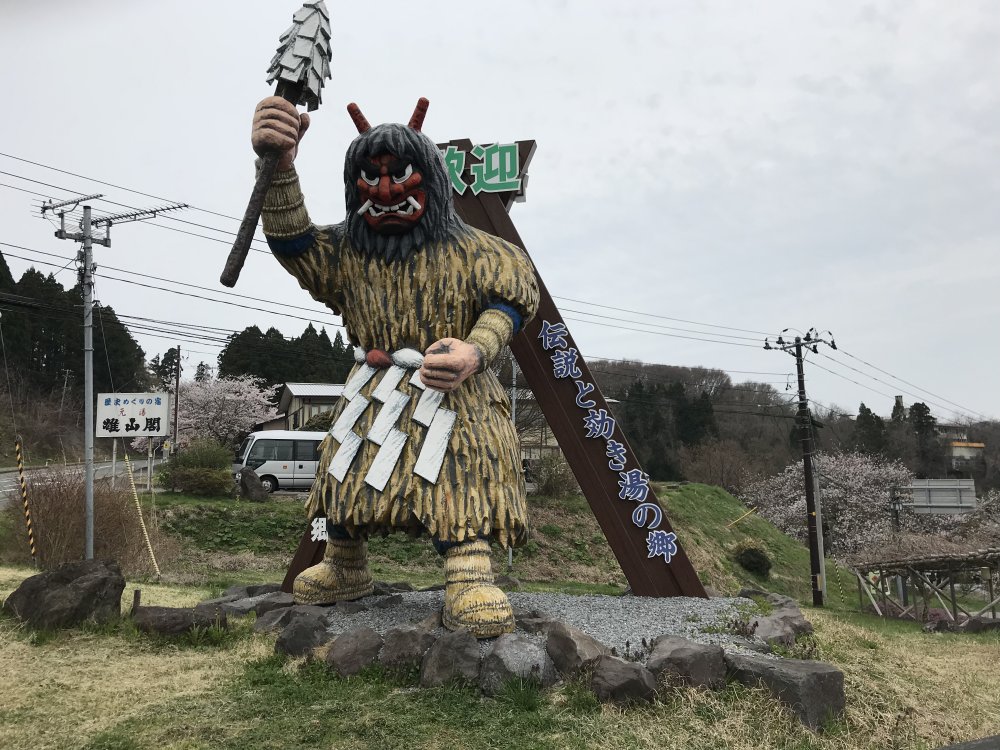
We were greeted by a Namahage statue at the entrance to Oga Onsen.
The journey on the following day was from Lake Tazawa to Oga Onsen on Oga Peninsula on the north west coast of Akita Prefecture. Rather than take the motorway through Akita City, we took the mountain road to the north, through Matagi country. Matagi is a reference to people that are professional hunters. Matagi areas are scattered in the mountains from Nagano, Niigata and the Tohoku region. These hunters maintained a spiritual belief in the mountain Goddess and performed rituals to pay respect to the mountain Goddess and the slain animals. Their history can be traced back to the Heian era, circa 10th to 12th century. In the Edo period only samurais had access to weapons, but Matagis were given special permission to own weapons for hunting. Bears were a very important target for their meat and skin and also for their gall bladder which is dried and used as a Chinese medicine for indigestion. The hunting period is during the snowy winters, during they would hunt as a group for days in the mountains. The number of professional hunters has diminished and the few that remain have other jobs in the rest of the year. There tradition is getting lost and attempts are been made to preserve the history. Ani area in Kitaakita City is a famous Matagi area.
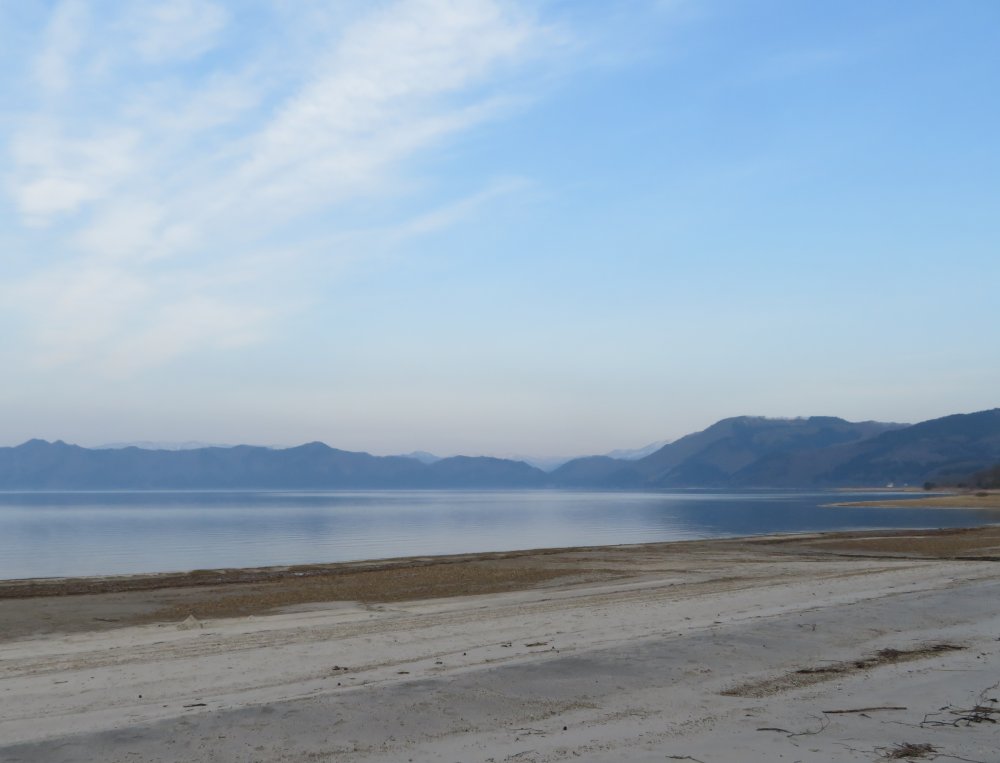
We left our hotel on the lakeside of Lake Tazawa early in the morning to head north to Amagi country.
We first went to the Matagi History Museum in Uttou Onsen about fifty kilometers north in the mountains. Akita Nairiku Railways which is owned and operated by local governmental bodies and companies runs side by side with the national road. The railway which was assembled and connected out of former JR and private railways runs from JR Kakunodate to JR Takanosu on the JR Oou Line running about a hundred kilometers. We were lucky enough to greet a train at Ani Matagi Station close to Uttou Onsen.
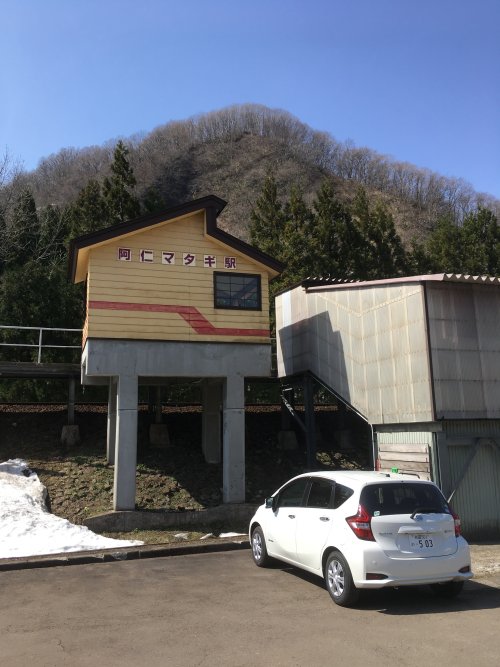
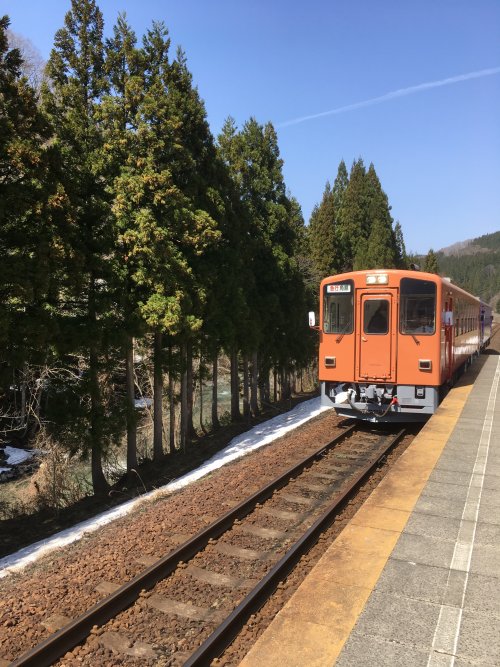
(left) Ani Matagi Station. (right) An express train to Kakunodate approaches the station on the single track Akita Nairiku Railway.
The History Museum is inside an onsen ryokan Matagi-no-yu. We learned a lot about the history of Matagi as well as their belief, hunting custom and life. I was intrigued to learn that their dried gall bladders were presented to the Tokugawa shogunate as part of the offerings (kenjouhin) from the Satake Family. It was the custom for feudal lords to present offerings to the shogunate usually composed of special local craft and food. This helped the preservation of local specialty goods in many areas. It was also interesting to know their close ties with the Ainu people, the indigenous people in Hokkaidou. The admission fee is only one hundred yen, so certainly useful to get a good feel of Matagi history.
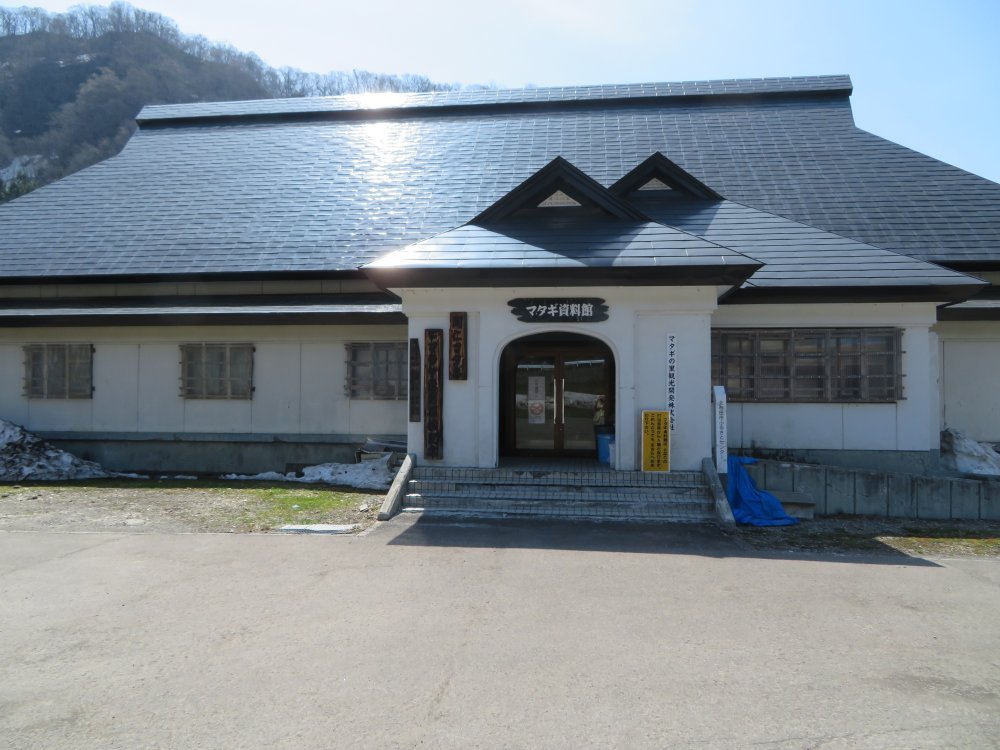
We learned a lot at Matagi history museum. You need to enter from the onsen ryokan on the right..
We went back to the national road and headed further north to the Okasinai and Nekko district. Okasinai in Japanese means comical and the “nai” may have come from an Ainu dialect, as in Wakkanai in Hokkaidou. Nai means river in Ainu dialect.
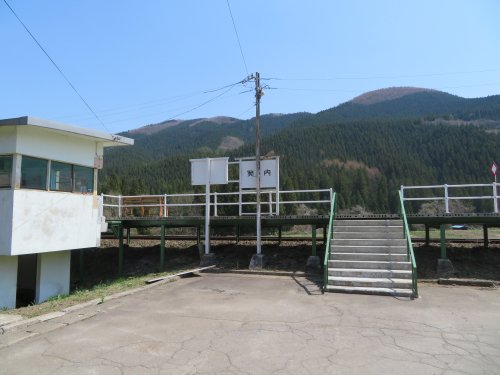
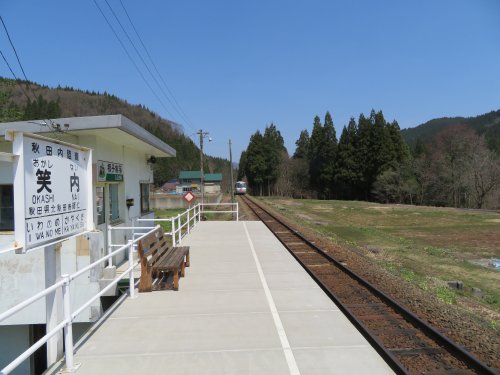
(left) Okashinai Station. (right) A train approaching Okasinai Satation. We were very lucky as the trains aren't thet frequent.
From Okasinai Station there is a narrow road into Nekko village. The road
leads to a long Nekko Tunnel, and once you leave the tunnel Nekko village
appears immediately down in front of you. Nekko is the district where the
Matagi originated. Legend says that some of the defeated Heishi people
fled into this village in the late 12th century. There are many areas in
the mountains that have a similar legend, such as the Iya district in Tokushima,
Northern Gifu and Toyama, Kawamata district in Tochigi and so on. They
have preserved a dynamic ritual Nekko Bangaku that has been designated
as a National Intangible Cultural Heritage. Bangaku is a style of Kagura
practiced in front of the Gods at Shinto shrines that later developed into
Kabuki. For more on Kagura, see Setsubun in the February article under
Season.
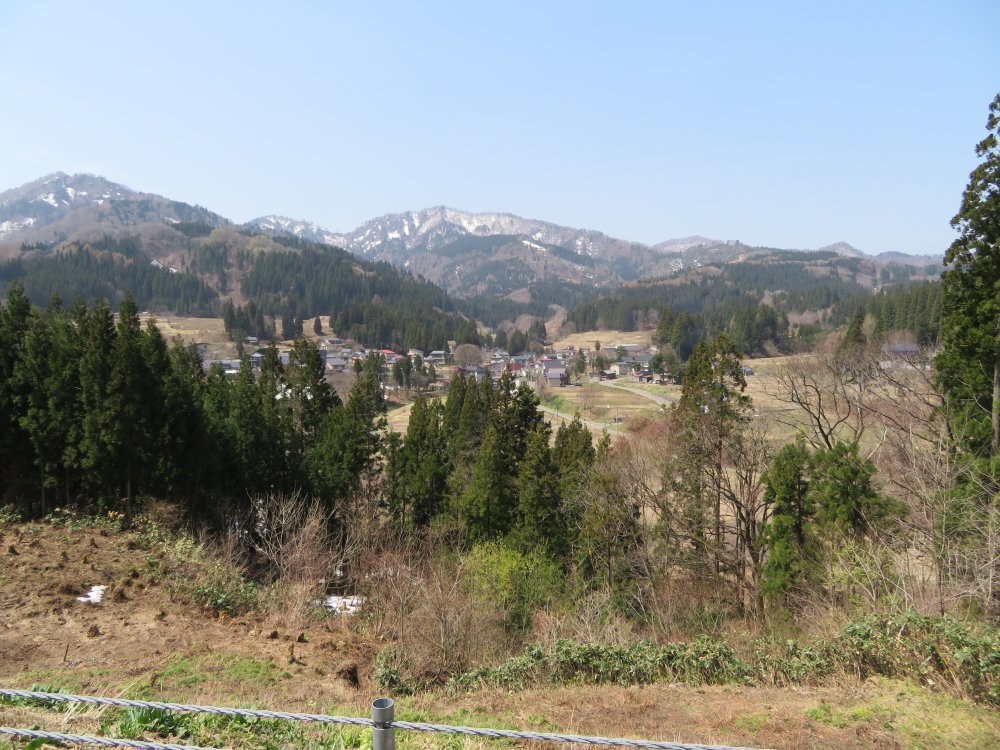
Once you leave the Nekko tunnel, Nekko village appears immediately down in front of you.
We went to pay a visit to Nekko Shinto shrine. We struggled to find where it was and went into a side road that came to a blank end. As we found a wider area and made a U-turn, we were lucky enough to accidentally come across a beautiful group of skunk cabbages in full bloom.
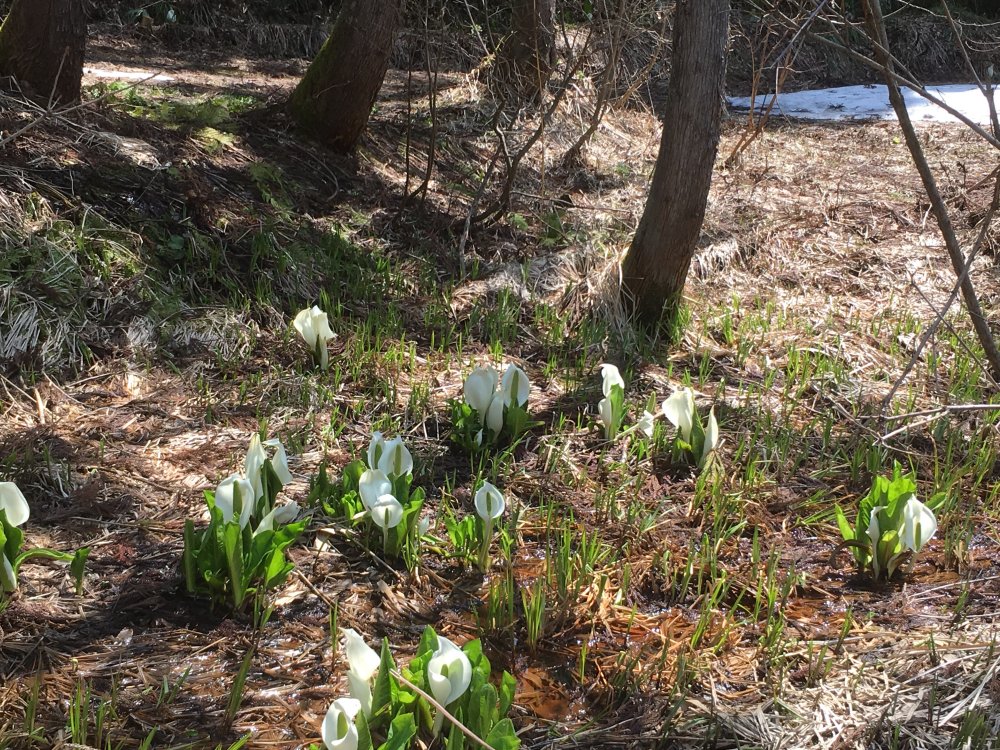
We were lucky enough to accidentally come across a beautiful group of skunk cabbages in full bloom.
As we came out of the side road we found a shrine on a hilltop. We went up the stairs and found that this was Nekko Shrine. This is known as Matagi Shrine, where the Matagi paid their respects to the mountain Goddess on important occasions including the start of a hunt. It isn’t a grand shrine but the atmosphere really suits the shrine for hunters.
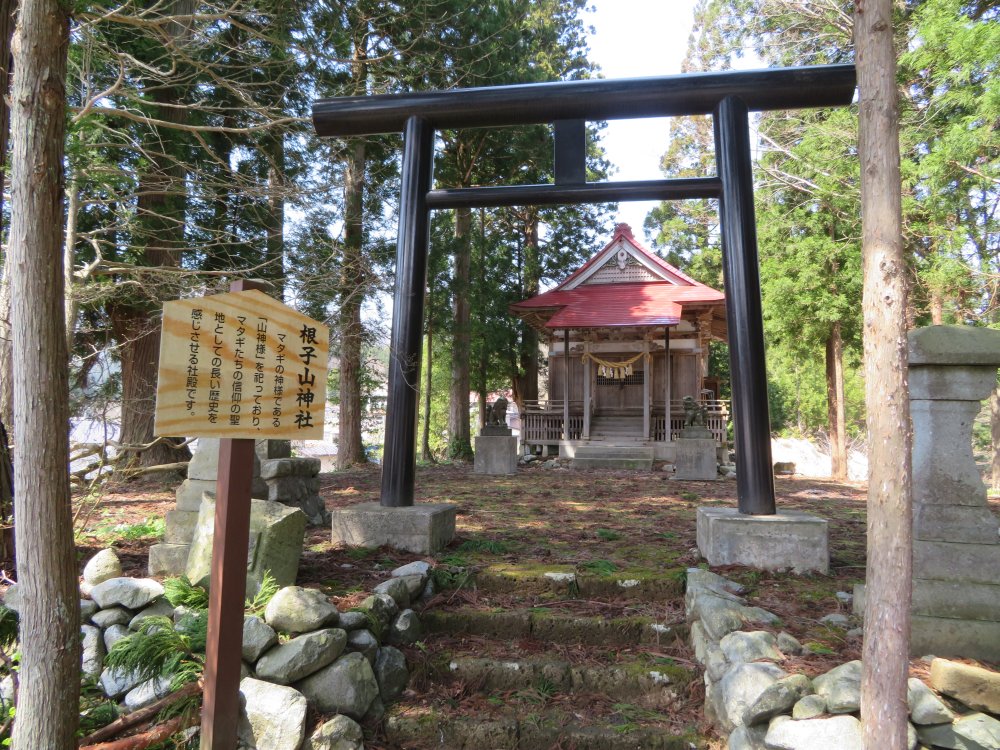
The signboard tells us that this shrine is dedicated to the mountain Goddess worshipped by the Matagi and called Nekko Mountain Goddess Shrine (Nekkoyamagamisha).
We left Nekko back to the national road and headed north to Ai district, more commonly known as Aniai. I didn’t know till this visit that Aniai was once one of the largest copper and precious minerals mines in Japan. All I knew was that Akita had a lot of mines and many refineries but that the ore has all been depleted. We first visited the local history museum Ijinkan (Foreigners’ House). This is a former residence of German mining engineers invited to Ani to modernize the mines in Ani, preserved and now converted to a museum. There is a modern building featuring the history of the Ani Mine to which Ijinkan is connected by an underground tunnel. The Ijinkan was similar to the one close to Sengan-en in Kagoshima Prefecture. The main display in the modern museum was more interesting. I learned with interest that Ani in the 18th century was the largest producer of copper which was Japan’s largest export through Nagasaki. The reorganization of the dozen or so mines into one headquarter orchestrated combined mine as well as the various modern production systems and mechanisms introduced contributed to increased production of the mines. I also learned for the first time that through the Edo area the mines were directly operated by Akita feudal domain, and then nationalized under the Meiji Government who encouraged inviting foreign engineers to promote the import of Western technology and afterwards sold to private companies, in Ani’s case to the Furukawa Group. Aniai ia a relatively large town in the area. I understood this was because this was where the mine headquarters were developed.
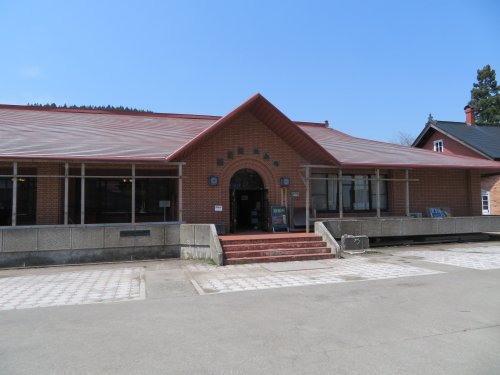
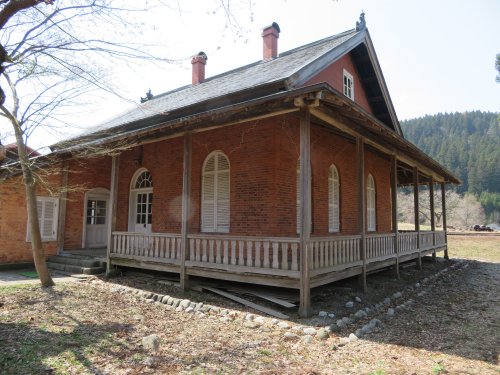
The local history museum (left) and Ijinkan (right). You can enter Ijinkan by an underground tunnel from the local history museum.
It may have been because it was a Sunday, but we really struggled to find a restaurant for lunch. There was a restaurant at Aniai Station but they didn’t serve local food which we wanted. We had to travel further north out of the mountain area to finally find a drive-in serving local food.
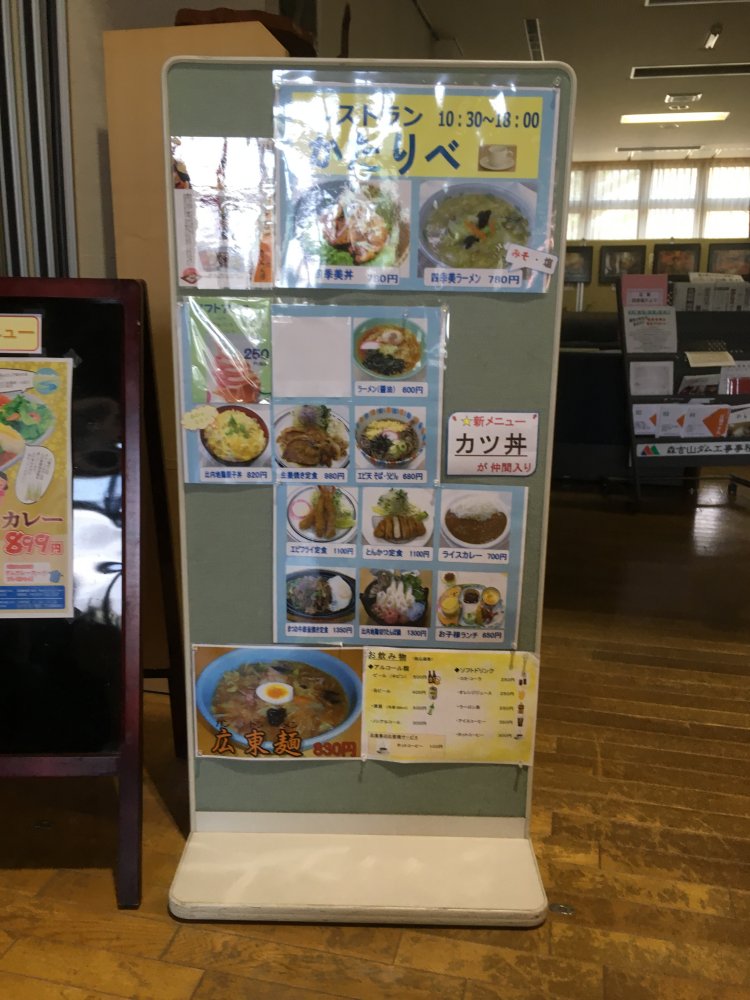
The restaurant inside the tourist information center offered some local pork and chicken dishes.
Driving further west to Oga Peninsular, we passed through Oogata Village. This is a large village created on reclaimed land. Hachirougata was the second largest lake in Japan after Lake Biwa but now only one eighth remains after land reclamation of roughly two hundred square kilometers. The reclamation started under a plan to increase paddy fields and hence rice production. With the help of Dutch experts, the reclamation work started in 1957 and was completed in 1964. The reclaimed land was plotted in one hundred hectare parcels and farmers were invited nationwide to move to Oogata to grow rice. Shortly after completion the Japanese Government reversed their policy and started to incentivize reduction of rice production. I recall there was lots of controversy as to whether the huge land reclamation had really made sense. There is a Land Reclamation Museum in Oogata Village that provides all the history of Oogata and the land reclamation. It paints a quite positive view of the effort.
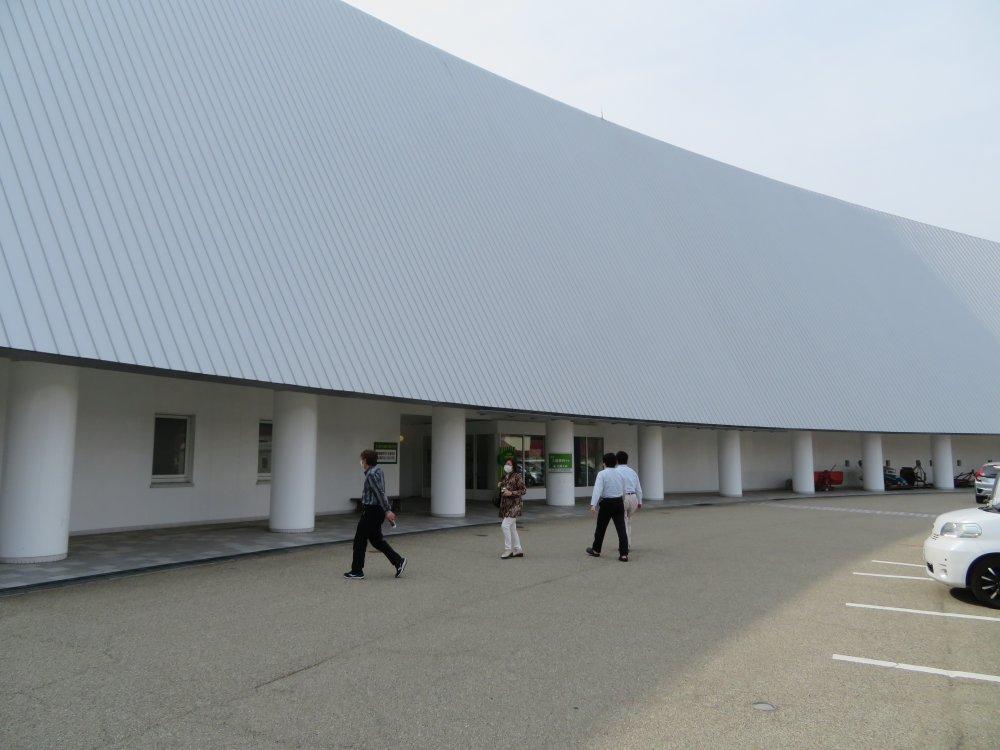
The Land Reclamation Museum in Oogata village. A quite positive view of the land reclamation of Lake Hachirougata was painted.
Our final visit before reaching the onsen ryokan we had booked was Kanpuuzan (Mount Kanpuu) on Oga Peninsular, further west of Oogata Village. All I knew about Kanpuuzan was that it was a particularly good spot to command a good view of Oga Peninsular and Hachirougata. I now understand that Kanpuuzan was an island created by volcanic activity which was eventually linked to the mainland through the accumulation of sand carried by river flow. We drove up to the mountain top which is about three hundred meters above sea level. There is no parking space at the top so we parked at the car park about fifty meters below. On the mountain top there is a gift shop and 360 degree rotating observatory. As we didn’t see anyone in the rotating observatory and felt the admission fee of one thousand yen expensive, we decided to skip and take a stroll around the area. I found that you can still get a good view of the coastline as well as Oogata Village although it was a bit hazy on that Sunday.
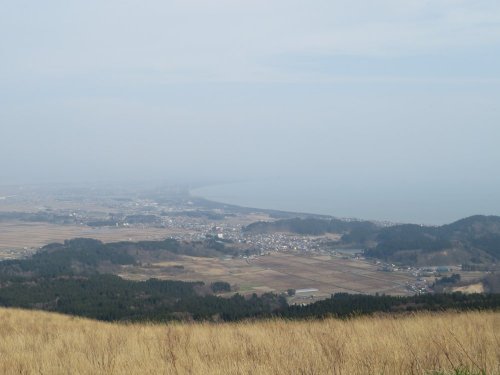
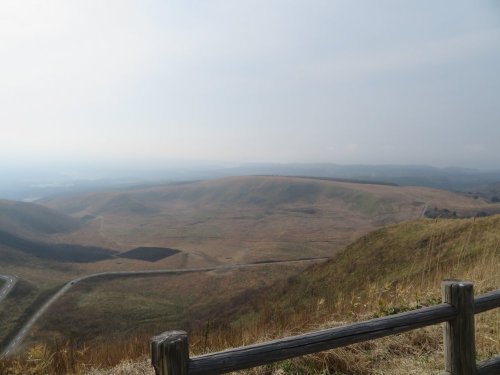
I found that you can still get a good view of the coastline as well as Oogata Village although it was a bit hazy on that Sunday (left). A volcano crater is quite visible (right).
We left Kanpuuzan for the onsen ryokan in Oga Onsen. Oga is known for an ogre like figure called Namahage that visits children to dispel evil and teach the children to be good. The custom is for men dressed in Namahage costumes to visit houses with children on December 31st. I understand that it is becoming increasingly difficult to preserve the custom, as there are fewer young men, many households are elderly couples with no young children due to the depopulation of the countryside. We were greeted by a Namahage statue at the entrance to Oga Onsen.
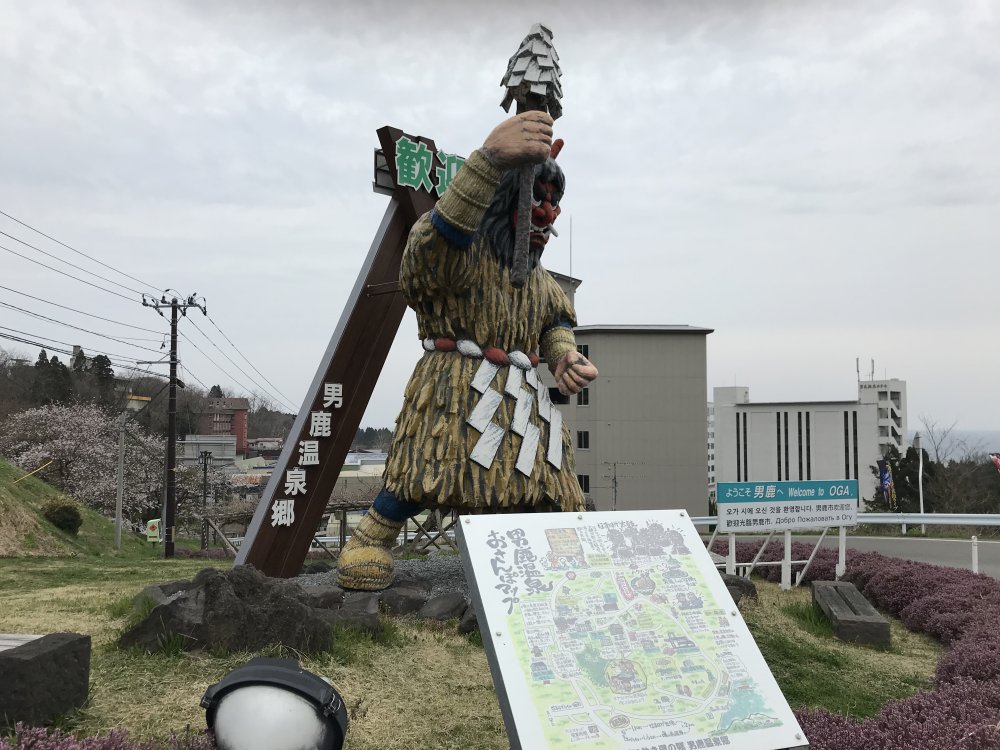
The Oga onsen township is behind the Namahage statue. The cherry blossoms were in full bloom.